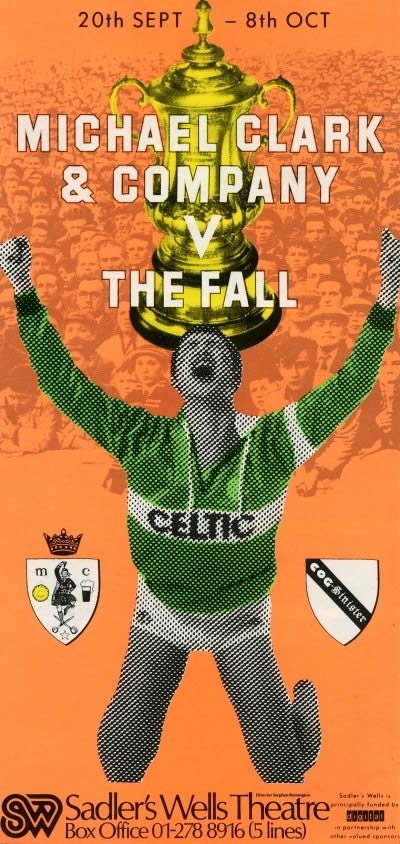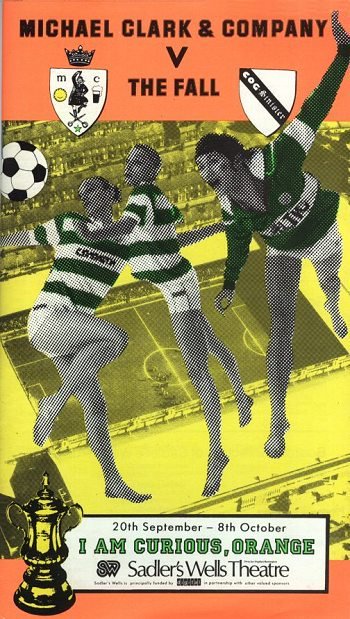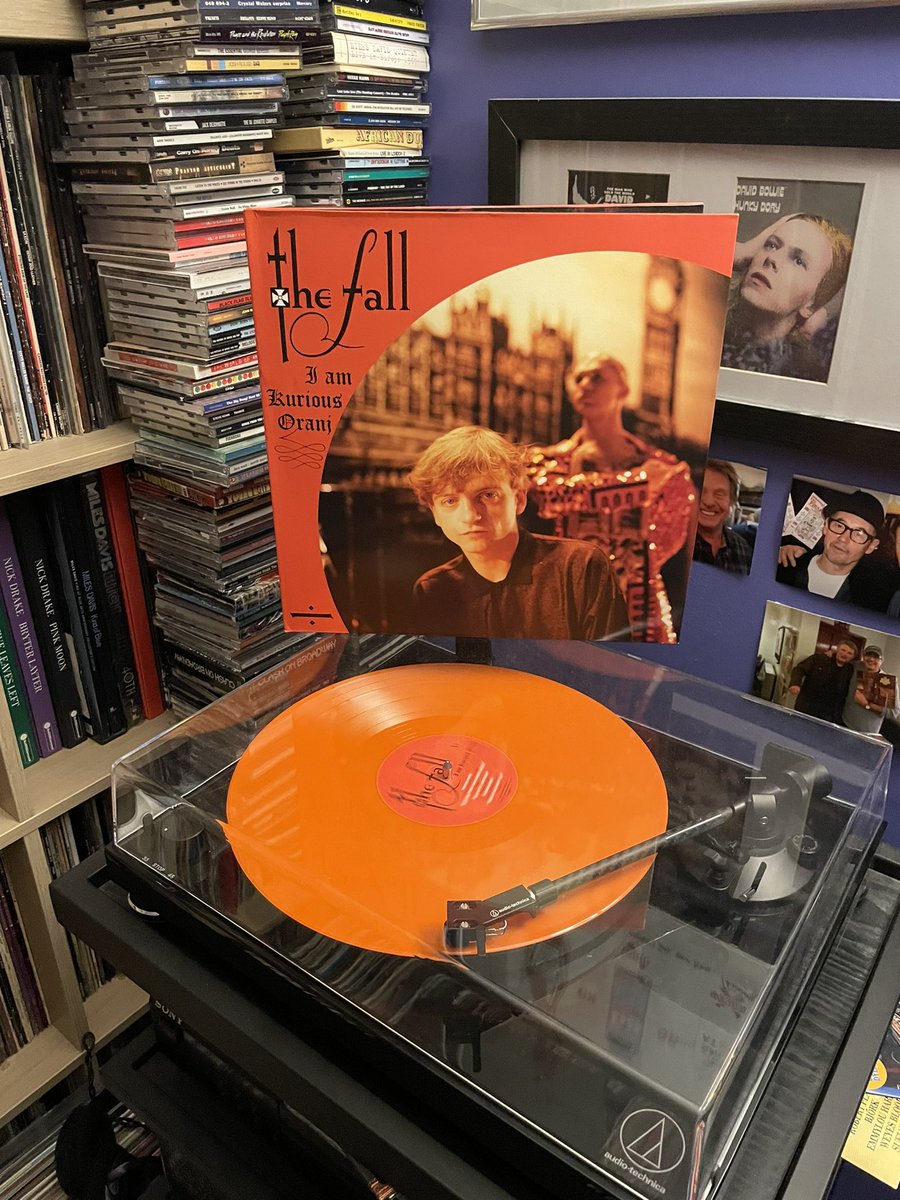Details
Date: 1988
Ref: A ballet performed using The Fall’s music with performers in Celtic tops!
Summary
Surprising as it may seem but there has been a ballet performance conducted utilising the Celtic jersey.
Manchester cult band The Fall were a huge influence on the alternative scene back in the 1980s-1990s, led by their irrepressible lead man Mark E Smith, and were championed by the legendary DJ John Peel as his favourite band.
In October 1988, the band released their well-received album ‘I am Kurious, Oranj‘, and is notable as the fruit of a ballet project between Smith and dancer Michael Clark. I Am Kurious Oranj’s title is derived from Swedish director Vilgot Sjöman’s films I Am Curious (Yellow) (1967) and I Am Curious (Blue) (1968).
‘I Am Kurious, Oranj’ was used as the soundtrack for the ballet I Am Curious, Orange. The music was mostly pre-written by Brix Smith and bassist Steve Hanley. It had some performances in 1988 (the same year as Celtic’s centenary season), with performers wearing the Celtic centenary tops!
The theme of the ballet was more or less William of Orange (1650-1702), aka William III (or colloquially as King Billy), and in some ways the song is about William of Orange (see lyrics below), but at times it seems to be about Protestantism in general. The ballet coincided with the 300th anniversary of his accession to the English throne. According to Mark E. Smith in his book, Renegade:
“We adapted the title from a Swedish porno film–I am Curious, Yellow. I was trying to make the point that we all share some kind of common knowledge that’s within ourselves; that comes out in all sorts of things. Some people call it a gene pool. It’s as if you already know subconsciously about historical incidents. You don’t have to have been taught it. It’s in-built. At the time I wanted to put this across, basically as a loose explanation of what was happening in Belfast: it’s in the head and bones and there’s nothing you can do about it.”
The reasoning for using the Celtic tops is mostly obvious but nothing should be taken as negative here. Mark E Smith is hardly anything establishment minded.
The ballet was a parody/homage to King Billy, at one point he wears a T-shirt saying, “There is only one King Billy and that’s McNeill!“.
A very ‘curious’ usage of the Celtic top in the history of the club.
Link:
- https://en.wikipedia.org/wiki/I_Am_Kurious_Oranj
- https://www.theguardian.com/stage/2011/apr/24/i-am-curious-orange-bunny-christie


The odd mix-up of Celtic, ballet and the music of Mark E.Smith and The Fall. I Am A Curious Orange (ha!) from 1988. pic.twitter.com/3ClwIPygpd
— Beyond The Last Man (@BeyondTLM) January 18, 2018
From Not The View Fanzine:



Kurious Oranj
http://annotatedfall.doomby.com/pages/the-annotated-lyrics/kurious-oranj.html
Lyrics
(1)
They were curious orange
They were curious oranj
Pained and intense, man (2)
They were inquiring
They were curious orange
They were curious orange
They rode over peasants like you, they rode over peasants like you,
And their horses loved them too, and their horses loved them too
They were curious curious curious orange
Curious curious curious orange
They were curious curious curious orange
They built the world as we know it, all the systems you traverse
Rode slipshod over all dumbshits
They were curious orange
They were curious orange
They were curious orange
They freed the Blacks too.(3)
They built church in one day, man,
Amish (4)
They were curious orange
They were curious orange
Ba ba ba ba
They were curious orange
Curious orange
They were curious orange
They were curious orange
Their clothes were cool
Paved way for atom bomb
They made the Jews go to school
They sent Hitler/missionary girls to Arab states, and the sun-baked men
did drool (5)
They were curious orange
They made Hitler laugh in pain
They turned Napoleon over and didn’t know
They invented birth control (6)
They were invulnerable to cool
They were curious orange
They were curious curious curious orange
They were curious orange
They were curious orange
They were beyond Ooobenblief (7)
They were primo efficient to a man.
They were Stuyvestant smoking. (8)
They were the Reformation spring
And everybody in the world turned Reformation blue
They were invulnerable to cool
And everybody in the world…
And they were inquiring
They were curious curious curious orange
They were positively deranged and they were curious orange.
They were curious orange
They were curious orange
Notes
1. The album I Am Kurious Oranj was written for the ballet I Am Curious Orange, choreographed by Michael Clarke and performed by his troupe to the live accompaniment of the Fall. The theme was more or less William of Orange (1650-1702), aka William III, ruler of England, Ireland, Scotland, and Holland. William was seen as a standard-bearer for the Protestant faith, deposing the Catholic James II, and waging war against the Catholic king of France, Louis XIV. In some ways the song is about William, but at times it seems to be about Protestantism in general. The ballet coincided with the 300th anniversary of his accesion to the English throne. According to Mark E. Smith in his book, Renegade, “We adapted the title from a Swedish porno film–I am Curious, Yellow. I was trying to make the point that we all share some kind of common knowledge that’s within ourselves; that comes out in all sorts of things. Some people call it a gene pool. It’s as if you already know subconsciously about historical incidents. You don’t have to have been taught it. It’s in-built. At the time I wanted to put this across, basically as a loose explanation of what was happening in Belfast: it’s in the head and bones and there’s nothing you can do about it.” (158-9)
Dan has discovered that, in conversation with Adam Buxton in Norwich in 2016, Brix says she came up with the title in reference to the above-mentioned film.
According to Russell, though, “I am Curious, Yellow is NOT a porn film – but when it came out (early 70s?) in Manchester there was only one cinema showing foreign films – Swedish, for example – and that also showed for-the-time porn, too, anything with a bit of nudity or a saucy title, nothing on the modern internet… WR Mysteries of the Organism also showed there, if i remember rightly. But the “I am curious” films are wonderful (and witty) examinations of bohemian/student lifestyles in generally stuffy 60s Sweden. The original film had Yellow as a suffix , while there’s a whole other film called I am Curious, Blue made up entirely out of outtakes, and almost as good as the first version (the two are complementary and can now be purchased together on dvd). The Yellow and Blue refer to the colours of the Swedish flag.”
^
2.The lyrics book has “pains in the arse, man” which makes more sense.
^
3. This may refer to the “Black Irish,” a term which may have been used by Catholics to describe Protestant Irish. However, I am unsure about this, having found little corroboration of this usage; it seems to more commonly refer to an Irish person with dark hair and features. England under William was heavily involved in the international slave trade, so the term probably doesn’t refer to those of African descent. There is a Royal Black Institution that is associated with the Orange Order, but this connection seems tenuous. Otherwise, MES seems to be having fun attributing all kinds of historical events to William III and his retinue. According to Keg on the Fall online forum, “The ‘Glorious Revolution’ and constitutional reform that went with it (historians generally include the Act of Settlement 1701 in this) is seen as the foundation of the modern state, ie parliamentary democracy, Bank of England, National Debt. The monarch would no longer be able to rule without a sitting parliament. So MES is just referencing things back to this pivotal time in British history, in an ‘it all started here’ way.” This seems as plausible an interpretation as I’ve seen.
^
4. The Amish originated in what is now Switzerland and parts of Germany toward the end of the 17th century. They are known for cooperative building projects, in which they raise a barn, a house, or a church in one day. The Amish (along with other new world Anabaptists) are largely Pennsylvania Dutch (a term in which “Dutch” is an old variant of Deutsch, or German) so they may also be lumped in here for the Dutch theme, as well as the Protestant one. Throughout, MES seems to be conflating William and his court with Protestants and Dutch in general, but even that may be too narrow an interpretation, as the following lines show…
^
5. Two vocals overlap here, with one taking the “Hitler” line and the other, seemingly edited in, taking up with “missionary girls.”
As far as I can make out, Protestant missions to the Middle East began in the early 19th Century.
^
6. Most of these deeds are not attributable to William or any of his crew. The birth control reference is again perhaps aimed at Protestantism in general. And, for the “Dutch” theme, the world’s first birth control clinic, I am told, was in Holland in the early 20th century. So it goes with the “gene pool” method of history (see note 1 above).
^
7. Uben blief means “overflowing.”
^
8. “Peter Stuyvesant” is a brand of cigarettes, named after the Dutch director of the New Netherlands (a large colony whose capital was New Amsterdam, which later became New York City). He held the post while William was the regent of Holland, and at one point New York City was called “New Orange,” when the Dutch briefly recaptured it from the British in 1673 (at this point William was the ruler of Holland, but not yet the king of England).
I Am Kurious Oranj Review
by Ted Mills
The Fall I Am Kurious Oranj Album Reviews, Songs & More | AllMusic
The last thing most Fall fans expected the group to do in 1988 was provide music for a ballet, but in fact this is what they did. Of course, it helped that the Michael Clark company of dancers were some of the most avant-garde at the time in Britain and were inspired originally by the Fall’s “Hey! Luciani” single. The concept, very loosely, centers around William and Mary of Orange, and finds Smith arranging William Blake‘s “Jerusalem” for the band, adding his own lyrics (“It was the fault of the government,” providing ironic contrast to the self-sufficiency espoused in Blake). As a cohesive Fall album it fails: The strongest tracks are those that have little to do with the ballet (and are available elsewhere). “New Big Prinz” updates their own “Hip Priest” into one of their heaviest tracks, full of threat and wonder. “Cab It Up!” features all forward momentum and jingling keyboards. For the first time tracks felt like filler, and indeed they were. The CD booklet contains photographs from the performance full of giant pop-art hamburgers and cans of baked beans, suggesting I Am Kurios Oranj would have been more interesting to see than hear.
I Am Kurious Oranj [Beggars Banquet, 1988]
Drones, vamps, laid-back forcebeats, and a steady stream of allusive satire add up to the enjoyable postpunk pattern of countless other Fall albums. Yet from the opening nag–“Check the record, check the record, check the guy’s track [later ‘rock’] record”–small strokes keep me turning this one up. First side’s got the nag and Brix’s drolly tinny AOR “overture” and William Blake. Second’s more patternlike, though who could resist the OMD-Stooges combo? Besides radio, I mean. A-
http://www.robertchristgau.com/get_artist.php?name=The+Fall
Chuck Eddy, “End of the Line”
VILLAGE VOICE, January 17, 1989, p. 78
http://www.visi.com/fall/gigography/89jan17.html
Formed in working-class (as if that matters) Manchester way back when Paul was pope and David Alien Coe LPs had “happy sides” and “su-i-sides,” the Fall are the one punk band that never reneged on the promise. By which I mean not just that these Brits kept their eyes on some pointless “struggle” against the wind, but that they never looked back, never turned decrepit, never deflated noncomformity into some mawkish parlor game, never succumbed to any square’s prefab notion of what a good time’s supposed to sound like or say or do. Me, I gave up on Patti in ’79, Pere Ubu and Wire and Elvis C. in ’80, John Lydon in ’81, Clash and Gang of Four in ’82, T-Heads in ’83, Mekons in ’87; head Fall-guy Mark E. Smith meanwhile initiated this theoretically limitless mumbled-nonsense-under-skewed-ooze aesthetic. It was eventually adopted by a kazillion one-trick ponies (Buttholes, Huskers, Minutemen, Jesus and Mary Chain, Pussy Galore), and he kept plugging away even as said aesthetic grew more obvious than whatever it meant to confront, even as thespianism, shock tactics, and propaganda songs shipped his heirs off to history’s glue factory. Sonic Youth, who pay split-second homage to the Fall in their “Teenage Riot” video and who’d sound lots different without ’em, have a fifth as many good records. The Velvet Underground is where Fall-primitivism mostly came from (also: Captain Beefheart, the garage, Naked Lunch, weirdo Teutonic droners like Can and Faust, weirdo Limey outcasts like Peter Hammill and Kevin Coyne and even John Lennon), but the V.U. quit after four albums, or maybe two. The Fall’s got something like 17. So far. Then again, last year annoying old Siouxsie Sioux made testier music than Steve Albini (who’s made a name reducing Mark E.’s history-mantras to corn), so for all I know prolific longevity means nothing.
No Fall stuff’s ever made me gag, but certain spans of dry didacticism leave me unmoved, un-anythinged. Fall oldies lack crassness, Fall newies lack intensity, it all lacks libido. Like with the Angry Samoans or Sonic Youth, non-pigeonholed non-stasis and stick-to-itiveness continue to lift this ever-mutating combo above the postmortem throng, but like with the Sams and Sonics, it doesn’t matter much anymore. None of which detracts from the unimpeachable fact that the new I Am Kurious Oranj (Beggars Banquet) is the best soundtrack to a Michael Clark ballet about a 16th century Dutch prince I’ve ever heard. Fall output since Mark’s American bride, Brix Smith, took the guitar reins in ’83 has almost been a hymn to domestic stability, real tight and tuneful, even perky, not so narrow or monolithic. I Am Kurious retains the clean textures and multimode scattershotness of recent years while trying not so successfully to regain some lost edge; there’s nothing as creepy as a blotto Mark babbling in the back bus seat that his friends don’t add up to one hand, nothing as dazzling as this oft-alleged reactionary (who once recommended that Band-Aid bucks be spent on birth control) out-neoconning the world in his proud semi-hit redo of the Kinks’ “Victoria,” both on the previous (and way accessible) Frenz Experiment. So the new one’s some backwards stab at careerism, maybe. But from Gary Glitter glop to new-age Fela, from West Bank eulogy to William Blake hound fetish, from demiclassy overture to flower porn parody, it’s a keeper nonetheless Marquis Smith’s one of those rare gents who wouldn’t know how to compromise (whatever that means) if he wanted to, and he obviously does. But what I’ve always appreciated most about him is that he always seems to know what he’s talking about, even when he’s going way over my head. He doesn’t have to think back on all the crap everybody else in art school. Only a brainy loner’s r’n’r dream could turn Status Quo’s screwball “Pictures of Matchstick Men” into a snide treatise called “How I Wrote ‘Elastic Man’,” could locate a Frankie Lymon screech in the center of a harangue on junkies missing Christmas, or could find an urgent ulcer-laugh but no belt to wear in that pile of garbage over there in the corner. Smith hectors on about McCarthy and Mao, cockroaches and midges, psychomafias and petrodollars and psilocybin. He panics, invents new slang and pronunciations on the spot. Then he suddenly switches into German, the language of a land he’s apparently convinced is haunted. Obsessed with Belsen and Salem (which ought to come off as cheap metaphors, but with him they don’t), this evangelist has no sympathy for devils, and he’s always lashed out at the normality his instincts tell him to embrace, fearing new superstitions could breed complete control. (Maybe they already have: Listen to “Second Dark Age,” recorded in ’79, and ponder how the ’80s turned out.) He’s at war with the technological death wish, wants to know what to do, whether there are worthwhile kicks that won’t crucify him. In “Various Times,” he signs on as a Nazi camp guard to avoid the front. His prettiest song’s about visitors getting beheaded on a Disneyland ride. His band’s named for a Camus novel, a moral breakdown, or the season the sun dies–any way you slice it, the end. I keep wondering when he’ll fall apart. Don DeLillo (who, like Smith, essayed Oswald instead of JFK last year), writes in White Noise (a title echoing the first words on the Fall’s 1978 debut single) that “the real power is wielded every day, in these little challenges and intimidations, by people just like us.” That idiot next to you at the laundromat. It could be Smith’s credo, and it’s pretentiously paranoid, and in an age when better-not-take-it-from-me antisocialism’s the norm, it’s not even that fun a neurosis to partake in. Yet with still no countercultural “community” around I could ever imagine wanting to be part of, the moods and monologues on my Fall vinyl make DeLillo’s theorem ring true. “I can’t live in those people-places/They might get to know my actions,” the voice snarls, gradually scaling this reduplicating pair of grind-away trance chords in “Frightened,” about the only song I know that could earn that title. “I don’t wanna dance/I wanna go home.”
This mob’s maddest music–’85’s compulsive “No Bulbs” 12-inch, the highstrung first side of ’79’s Live at the Witch Trials, all that brooding double-drummed pore congestion crammed onto Hip Priest and Kamerads–is the raw gnaw of discontent, the ‘loather’s leap into something infallible, that’s always made punk-weaned rock change its mind, turn smug. If Kurious Oranj isn’t, it’s not because Smith has changed his, but ’cause he realizes misanthropic murk can no longer move mountains. If he ever figures out what can, get out the way, okay?
The best performance I’ve ever seen: Bunny Christie
I Am Curious, Orange by Michael Clark Company, Sadler’s Wells, London, 1988
Michael Clark Company and The Fall. ‘I am Curious Orange’
‘An electric spectacle‘: Michael Clark Company in I Am Curious, Orange at Sadler’s Wells, 1988. Photograph: Dee Conway/ Lebrecht Music & Arts
Interview by Mina Holland
@minaholland
Sun 24 Apr 2011 00.05 BST
I take every opportunity to see Michael Clark dance, but his performance in I Am Curious, Orange stands out in my memory. There was a rock’n’roll excitement to the night – it felt more like a gig or a party than a show. Clark’s classical movement amid the striking set and raucous music made for an electric spectacle.
Clark’s composure was luminous. Despite the wild and frenetic scene – the band onstage, the Houses of Parliament as a backdrop, Brix Smith [a member of the band the Fall, who did the music] and guitar atop a giant hamburger – he had this sense of calm about him. He emerged with a shaved head and a low-cut top exposing his chest. He glowed in the darkness.
There’s something magical about Clark. Not only is he very beautiful, with huge, feminine lips and slender limbs, but when he performs he’s totally absorbed in himself. Though the dances were very flamboyant that night he had this tranquility about him. I got the impression that he’d have been there dancing classical ballet in platform shoes whether the audience were there or not! Dance comes naturally to him.
I saw the show at Sadler’s Wells in 1988. I’d finished art school and was living in London. Something about the performance spoke to me about the time and the circles I was moving in. I felt this natural affinity with both the performers and the ambience – I felt part of it. I’ve grown up with Michael Clark, having seen him perform throughout my theatre-going life. I don’t think I’d like to meet him, though. I’m happy being a fan and a member of his audiences, both surprised and delighted by each new performance.
I’ve never designed for ballet. It’s for this reason that going to dance shows feels like a proper night out, and I enjoy being a paying member of the audience. I watch ballet with amateur eyes. That said, there’s an enormous theatricality to Clark’s work, which I’m sure is part of my attraction to it. The essence of his soul shines onstage – he has a purely creative imagination.
